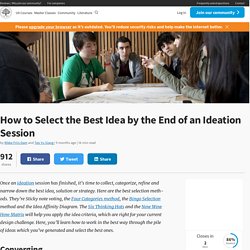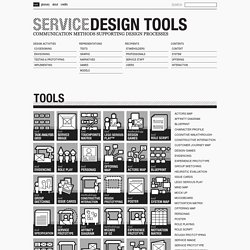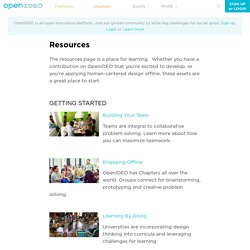

How to Select the Best Idea by the end of an Ideation Session. Once an ideation session has finished, it’s time to collect, categorise, refine and narrow down the best idea, solution, or strategy.

Here are the best selection methods. It’s Post-it voting, the Four Categories method, the Bingo Selection method and the Idea Affinity Diagram. The Six Thinking Hats and the Now Wow How Matrix will help you apply the idea criteria, which are right for your current design challenge. Here, you’ll learn how to work in the best way through the pile of ideas which you’ve generated and select the best ones. Converging At some point in your ideation session, you’ll have reached a critical mass of ideas, and it will become unproductive to attempt to keep pushing for more. Post-it Voting or Dot Voting Author/Copyright holder: Teo Yu Siang and Interaction Design Foundation. Best practice: You write all of the ideas which have been generated in the ideation session down on individual Post-its. IBM Design Thinking. Introduction - 18F Method Cards. Design Kit Travel Pack by IDEO.org. Library of facilitation methods. Ideo. Sans titre. Klap : Ateliers de Design Thinking.
Design Thinking Resources For Practitioners. Ben Yoskovitz on lean product development, using metrics to build successful products and companies March 2, 2017, 2:55 pm – The O’Reilly Design Podcast: Build measure learn, the One Metric That Matters, and balancing hubris and humility.

In this week’s Design Podcast, I sit down with Ben Yoskovitz, investor, entrepreneur, and former VP of product at VarageSale... [ Listen to the episode ] Methods. Methods We’ve lined up a number of activities to help you understand, define, make, and release circular innovations.

Dive in wherever makes most sense for you and your team.Don’t worry about getting it all right on your first go. The more you prototype and learn, the greater your positive impact on the system. Thank you! Your submission has been received! Oops! Curated Links for “Design Thinking” I’ll jot down here a few links and pointers on design thinking as the topic comes again and again and I’m always glad to share on this topic.

Concept Design Thinking as introduced by Tim Brown from Ideo. The Blog is interesting for the story, what came after and what he is doing now. Open IDEO is a place for resources on Design Thinking. This is the picture describing the process in 5 steps. Design Thinking for Educators. Nature Cards. Ideo. MethodKit. Repository. Design activities Co-designing Envisioning Testing & Prototyping Implementing Representations Texts Graphs Narratives Games Models Stakeholders Professionals Service staff Users Context System Offering Interaction Actors map Affinity diagram Blueprint Character profile Cognitive walkthrough Constructive interaction Customer Journey Map.

This is Service Design Thinking. Play With Ideas. Ideation Toolkit. Learning Resources. IBM met à disposition son guide interne de design thinking. IBM agit intelligemment en publiant ouvertement son approche interne du design thinking, déjà parce que le document est très complet avec 29 pages, divisé en deux parties (théorie et fiches pratiques).

Mais aussi parce que documenter ses méthodes de conceptions internes est la meilleure preuve de la qualité d’un service ou d’un produit. Ce qui est bien fait également, c’est d’avoir adapté les méthodes de design thinking en fonction du contexte d’entreprise. Ce document se positionne comme un vrai guide de travail pour tous les employés d’IBM, du moins pour les principes fondamentaux du design thinking. La logique utilisée par IBM est calquée sur la logique initiale du design thinking, cependant ils ont su l’adapter par rapport à leurs besoins et fonctionnements.
On remarque d’ailleurs que le document est actuellement la v3.4, un clin d’oeil au principe que « tout est prototype ». Interaction Design Foundation. Design Thinking is a design methodology that provides a solution-based approach to solving problems. It’s extremely useful in tackling complex problems that are ill-defined or unknown, by understanding the human needs involved, by re-framing the problem in human-centric ways, by creating many ideas in brainstorming sessions, and by adopting a hands-on approach in prototyping and testing. Understanding these five stages of Design Thinking will empower anyone to apply the Design Thinking methods in order to solve complex problems that occur around us — in our companies, in our countries, and even on the scale of our planet. We will focus on the five-stage Design Thinking model proposed by the Hasso-Plattner Institute of Design at Stanford (d.school). d.school is the leading university when it comes to teaching Design Thinking.
The five stages of Design Thinking, according to d.school, are as follows: Empathise, Define (the problem), Ideate, Prototype, and Test. 1. 2. 3. 4. 5. Design Kit. Resources. The resources page is a place for learning.

Whether you have a contribution on OpenIDEO that you're excited to develop, or you're applying human-centered design offline, these assets are a great place to start. Building Your Team Teams are integral to collaborative problem solving. Learn more about how you can maximize teamwork. Engaging Offline OpenIDEO has Chapters all over the world.